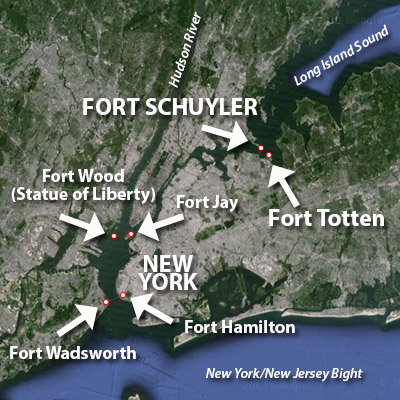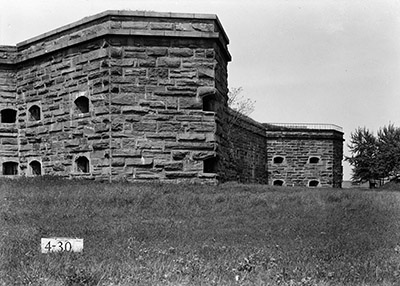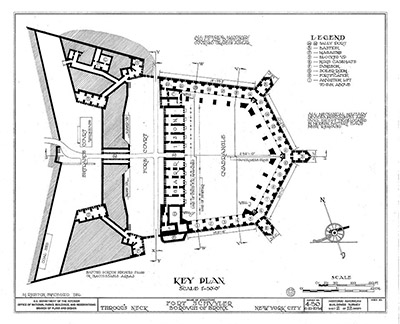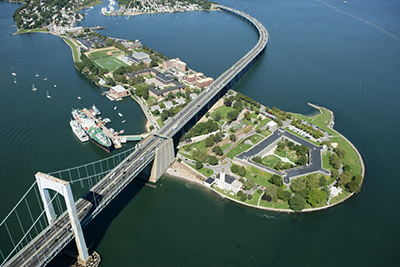 |
Fort Schuyler
Throggs Neck, New York, USA
|
|
 |
Constructed: 1833 - 1856
Used by: USA
Conflicts in which it participated: None
|
Throgg's Neck is a narrow land-spit that juts heroically into Long Island Sound where it meets the East River. A settler by the name of John Throgmorton obtained permission to built his home there in 1642 from New Amsterdam's Dutch governor. Once Throgmorton passed away, the locals breathed a sigh of relief and shortened the spit's name to Throgg's Neck.
Philip John Schuyler (1733-1847) was a general in the Continental Army during the American Revolutionary War (1775-1783). His military career seems to have mostly consisted of planning attacks in which he did not participate and not getting along with General Horatio Gates (1727-1806). |
 |
 Confused? Me too. Confused? Me too. |
|
After the war, Schuyler served in the New York State Senate and was elected to the first US Congress in 1791, representing New York. The separate entities of Throgg's Neck and Senator Schuyler would finally become one in 1833, when ground was first broken for Fort Schuyler.
|
 Two of Fort Schuyler's bastions, before the world became color. |
 |
Throgg's Neck was first identified as a good spot for a fort to defend New York's northern approaches in 1818. The United States was picking up the pieces after the War of 1812 (1812-1815) with Great Britain, and was determined that its coasts wouldn't be so lightly defended the next time the Royal Navy came a-callin'.
The Federal Government bought 52 acres of land on Throgg's Neck in 1824, and construction of Fort Schuyler finally started in 1833. The fort was designed in "the French style," which used to mean a good ole starfort in the 18th-century sense, but by the 1830's that meaning had changed.
|
|
|
With the art of artillery ever advancing, militaries around the world were changing their fortification tactics. The starfort we know and love was being replaced by the polygonal fort, whose lower, more robust walls were intended to counter the advantage of exploding shells, accurately fired from rifled guns. Fort Macon and Fort Pulaski, two other forts built in the US in this timeframe that attempted to take advantage of these new design theories, fared very poorly indeed against those aforementioned rifled guns during the US Civil War (1861-1865)...despite their new-fangled innovations. The truth was that the technology of artillery had already eclipsed the masonry fort, but it would be another 60+ years before everybody would face up to it.
|
At the end of 1845, Fort Schuyler was far enough along for guns to be mounted. The fort was built of granite shipped in from Connecticut, and designed for a garrison of 1250 men. Two tiers of guns in casemates poked out from the fort's walls, and entrance could only be gained through a drawbridge and tunnel that was loopholed so that any attackers that made it that far would be fatally inundated with musket shot.
Fort Schuyler's guns were all installed by 1856, which is really the most important part of a fort, so even though the rest of construction was only 75% complete the fort was officially declared open for the business of defending New York that year.
|
 |
 An Historic American Buildings Survey of Fort Schuyler from 1934. An Historic American Buildings Survey of Fort Schuyler from 1934. |
|
In 1862 work began on Fort Totten, across the mouth of the East River from Fort Schuyler. More on Fort Totten below. Fort Schuyler was garrisoned by an artillery unit, which kept careful watch for Confederate raiders and/or marauding Europeans through the US Civil War. Up to 500 Confederate prisoners were imprisoned at Fort Schuyler during the war. It also housed the 2,000-bed McDougall Hospital, and served as a collection and embarkation point for New York infantry units. The fort had an extremely effective and advanced waste removal system for the time: No one at Fort Schuyler died from disease during its active service. For a military hospital and prison in the 19th century, this was an impressive accomplishment indeed. The 1870's were a confusing time for American starforts. The US government was aware of the need to upgrade its seacoast defenses to keep its shores secure from the technologically advanced navies of potential European foes, but the Civil War had been such an exhausting enterprise that most folks didn't want to even think about military things. As such, several far-reaching plans to upgrade defenses along America's east coast got started, but a grand total of none of them were completed.
|
 Today, Fort Schuyler houses SUNY Maritime College. |
 |
Fort Schuyler's artillerymen were pulled out on October 12, 1870. The fort stood idle for three years, until work was begun on paving the way for modern 15-inch guns to be emplaced. This work was abandoned in 1875, however, for what would become a tragically familiar lack of congressional commitment.
The infantry moved back in and garrisoned the fort in 1877, making do with whatever guns were left there from the Civil War. In 1896 vast streams of money were released for a proper upgrade of America's seacoast defenses, thanks to the efforts of William Crowninshield Endicott (1826-1900), US President Grover Cleveland (1837-1908)'s Secretary of War. |
|
|
Fort Schuyler itself remained unmarred by the improvement process: Four external batteries were built on Throgg's Neck just outside the fort, which added two 12-inch and two 10-inch Disappearing Guns, and two 5-inch and two 3-inch rapid-fire guns to New York's defensive armament.
By 1913, a variety of huge guns had been installed at Fort H.G. Wright on Fishers Island, at the mouth of Long Island Sound. That fort was named headquarters of the Harbor Defenses of Long Island Sound, making Fort Schuyler so much excess baggage. Coastal Artillery troops were withdrawn from Fort Schuyler in 1911, and all of its big gun tubes were sent to Europe to play with the big boys during the First World War (1914-1918). The fort's final garrison of engineers left in 1931.
The Works Progress Administration sent its scruffy (but well-intentioned) workers to refurbish Fort Schuyler in the mid-1930's, and then the New York State Merchant Marine Academy took possession of the fort in 1938. That school is now the State University of New York Maritime College, which occupies Fort Schuyler today. I also have it on good authority that this fort makes an appearance in the movie The Amazing Spider-Man 2 (2014): Thanks to my nephew Henry for that heads-up!
|
Any fort at a bottleneck of a river needs another fort on the other side of the bottleneck! Congress funded Fort Totten, named (in 1898) for Chief Engineer of the US Army Joseph Totten (1788-1864), in 1857. Work began on the fort in 1862, and was discontinued in 1864 when it became evident, from events such as the defeat of Fort Pulaski, that rifled cannon could make short work of such fortifications.
|
 |
There's not much left of Fort Totten today: This is what's left of the Water Battery. Click the picture for a slightly better view! |
|
With the big rifled guns of the end of the 19th century came the realization that having an impressive fortification associated with your cannon wasn't particularly important. If you were engaging an attacking naval force at a greater distance than that from which he could fire at you, then you didn't even need a big beautifully impregnable starfort. Which is a sad realization indeed, but that's progress. A battery of 12 mortars and the 27-gun Water Battery were built at Fort Totten in the 1870's.
From 1894 to 1910 Fort Totten spent its Endicott money, piling on the usual Disappearing Guns, mortars and rapid-fire guns, most of which were duly sent to Europe during the First World War. In 1954 the fort was armed with Nike missiles, to defend New York from the nonexistent endless clouds of Soviet intercontinental bombers.
Fort Totten ended its run as an anti-aircraft battery in 1974. Today it is owned by the New York City Department of Parks & Recreation.
|
|
|
|
|
|
 |




